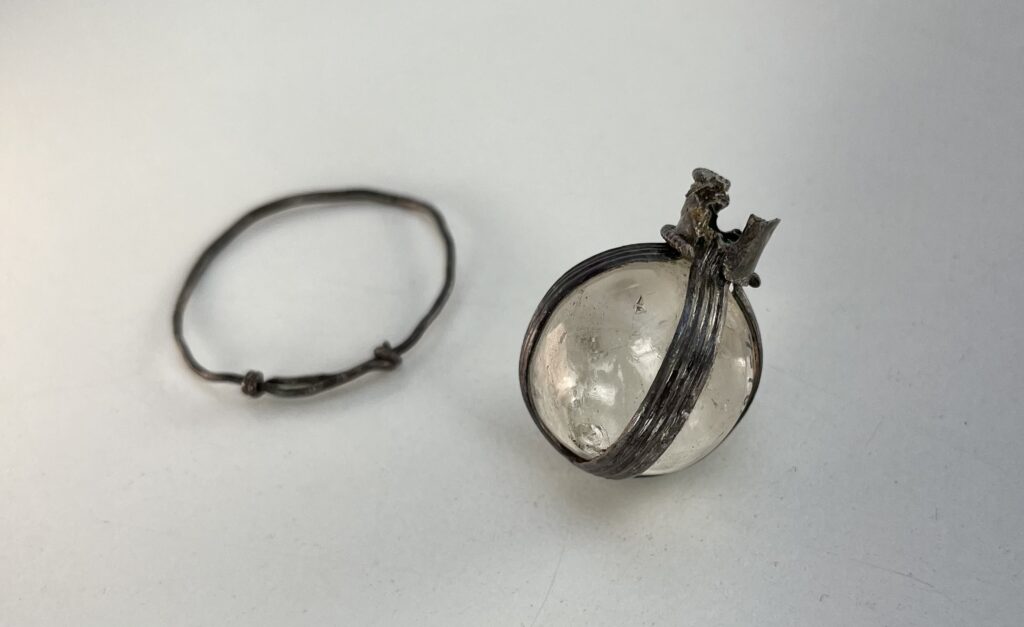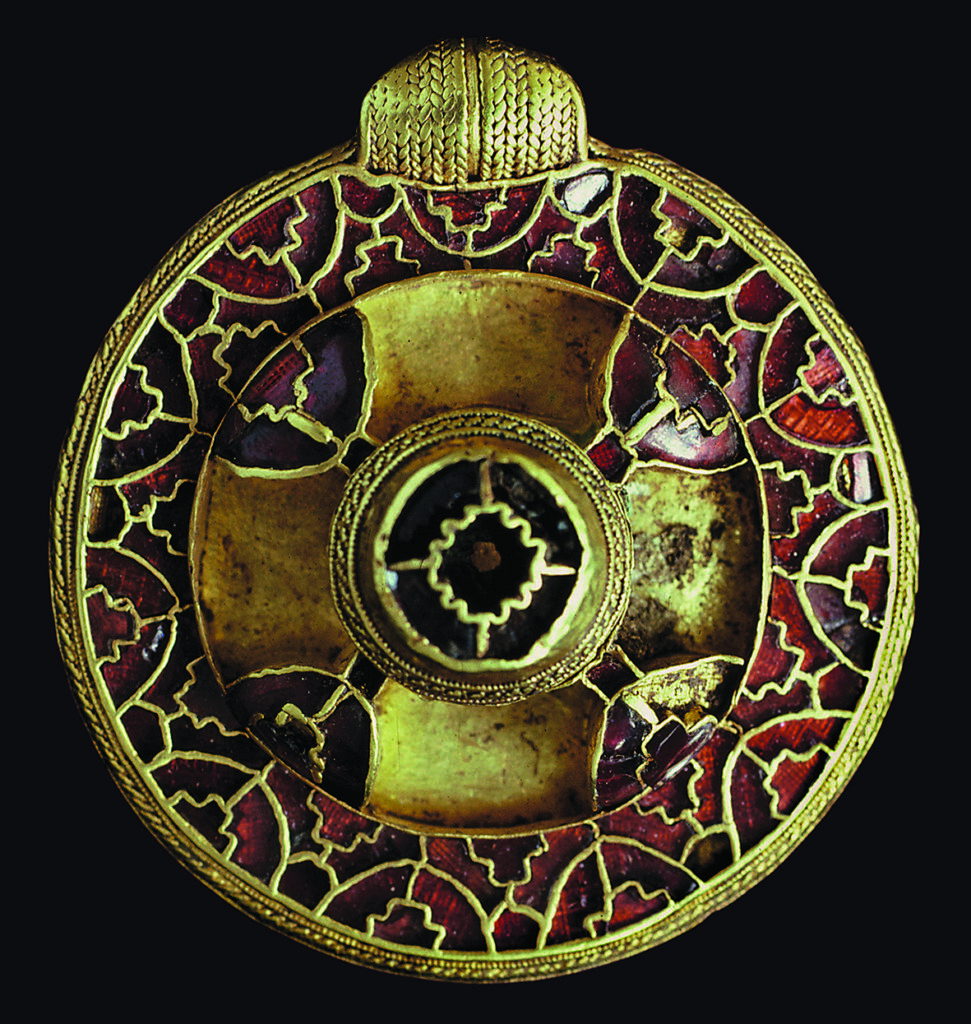Women in the Anglo Saxon Kingdom of Kent
To celebrate International Women’s Day 2024 Hannah Robson and Philippa Hornsby, Museum Interns 2023/24 are curating a display showcasing a diverse collection of artefacts and artwork associated with women from the museum collection.
Some items chosen were definitely owned by women, such as the tatting spool, as this was donated by a woman. Other items would have most likely been owned by women, such as the milles feuilles brooches and the crystal sphere. Others were used by both men and women, but the history of these items are important in terms of gender identity and how they were used, such as cosmetic containers and pilgrim badges.
For this blog, Hannah and Philippa have both chosen one item each, one from the exhibition, and one from the permanent galleries and discuss the importance of each item in relation to women, International Women’s Day, and local history.

A Crystal Sphere and Silver Spoon chosen by Philippa Hornsby
On the more mysterious side of museum objects, these Anglo Saxon items seemed to have intrigued more than one visitor to The Beaney. Located in the Explorers and Collectors Gallery, in the Anglo Saxon Kingdom of Kent display, the crystal sphere and silver spoon have typically been found together in female graves, and almost exclusively in Kent.
The crystal sphere is wrapped in a silver sling, with a silver wire ring attached at the top, and when discovered in graves the sphere is normally lying between the thighs. This would suggest that they were most likely worn hanging at the front of clothing, perhaps on a belt.
Examples of crystal spheres are typically made from quartz, which can be found all over Britain, and historically had many uses. Due to the strength and hardiness, quartz tools and weapons were common but white quartz, similar to these crystal spheres, would also be found in and around graves dating as far back as the Bronze Age. This could be for tomb decoration like headstones, or quartz boulders used to build burial mounds. There are also references from around Britain to healing properties that quartz and other crystals may possess, connotations that have been referred to when researching the possible uses of the Anglo Saxon crystal spheres.
While we could not know for certain the real reason quartz was important in the past, we can consider the present day uses and value. Quartz has a piezoelectric property, meaning that when pressure is applied to certain materials, a small electrical charge is produced, which quartz is able to do very well. Examples that use quartz for this purpose are some ‘Quartz Watches’ and it proved to be very popular during both World War I and II, with one of the first devices using quartz being sonar.
Other examples of crystal spheres have been found in the European continent, but when in Kent, the graves are unusually rich and found with the previously mentioned silver spoons.
Silver spoons found alongside the spheres are known to have holes pierced in the bowl, otherwise known as perforation. This example of a silver spoon does have this feature, as well as being gilded and engraved with a fylfot at the top of the handle. Similar styles of spoons have also been found on the continent, however it has been noticed that the quality of the Kentish spoons are more ornate both in design and in materials used. There are a few suggestions of how these spoons might have been used, with a more popular idea being a ‘skimmer’ used for straining wine or mead. In the sixth century, wine would have been a luxury item and silver spoons or skimmers of quality craftsmanship used in these scenarios would have been both practical tools and status symbols.As they are so commonly found alongside each other, it’s thought that they may have been used together, perhaps ritualistically. As mentioned before, crystals are said to have healing properties, and crystal balls/spheres conjure visions of fortune telling and prophecies, with women typically taking on the roles of mystics and witches. A common theory is using them together to symbolically purify and filter water, perhaps intended for a magical purpose.

The Canterbury Pendant chosen by Hannah Robson
This Anglo Saxon pendant was discovered in a female grave in what was a Roman and Anglo Saxon burial ground, located at what is currently Cranmer House, London Road, Canterbury. It was found in 1982 alongside 53 other burial sites in the same location.
It has been dated to c. 620 – 630 AD, and was found in a previously robbed grave with no bodily remains. Found nearby was a sceat (coin) from 700 – 720 AD, and Roman pottery from 150 – 250 AD.
Canterbury Museums and Galleries reference CANCM:1982.14.23, Explorers and Collectors, The Anglo Saxon Kingdom of Kent case.
The red garnet gemstones most likely originate from Sri Lanka, but were exported to East Kent to produce the pendant locally, probably in Faversham. These items were of intricate design and quality craftsmanship, and clearly made only for wealthy men and women, perhaps even those with links to nobility. This pendant would have been produced during the reign of King Eadbald of Kent (616 – 640 AD).
Inspired by Byzantine jewellery of the vast Mediterranean Empire, many Anglo Saxon pendants, brooches, and necklaces featured vibrant jewels and intricate gold metalwork to for decoration and to display wealth. This specific design is Christian, a new religion to Kent at the time, as the empty central spaces would have been filled with a white calcite material, possibly shell, to form a cross, which was common in Kentish jewellery of sixth and early seventh centuries.
The details on the pendant suggest it would have been worn and cherished by a woman of high status. It has been suggested that the object was originally a brooch, later altered with the addition of a loop on top, which helps to more accurately identify the age of the grave. There is also evidence of further minor modifications to the structure some time after it was made.
Women in Anglo Saxon England had a considerable amount of rights if they were not slaves, which both men and women could be. Women could own and inherit land and property. The first King of Kent, Æthelberht, issued the first set of modern laws in England. Five items from this code have been interpreted as a woman’s financial rights after a divorce or legal separation. Women could have private influence, intervene in public affairs, and lead religious houses.
Following the adoption of Christianity in Kent in 597 AD, women could be raised to sainthood, and this was observed almost immediately. Christianity offered more opportunities for women, and gave them almost equal status to men; women in the convent were also highly respected. Queen Bertha, later Saint, was highly responsible for the conversion of England to Christianity, due to her influence on her husband, King Æthelberht, and close relation with Saint Augustine.
Similar pendants and brooches include the Wilton pendant cross, the Ixworth pendant cross, the Sarre brooch, and several pendants and brooches found in King’s Field, Faversham. This item is currently on display in the Explorers and Collectors gallery, in The Anglo Saxon Kingdom of Kent caset.
Local historical women trails, including Queen Bertha’s Walk and the Mary Tourtel Trail are available from the Visitor Information Centre at The Beaney. Visit the International Women’s Day display at The Beaney in early March 2024 to join the conversation!
